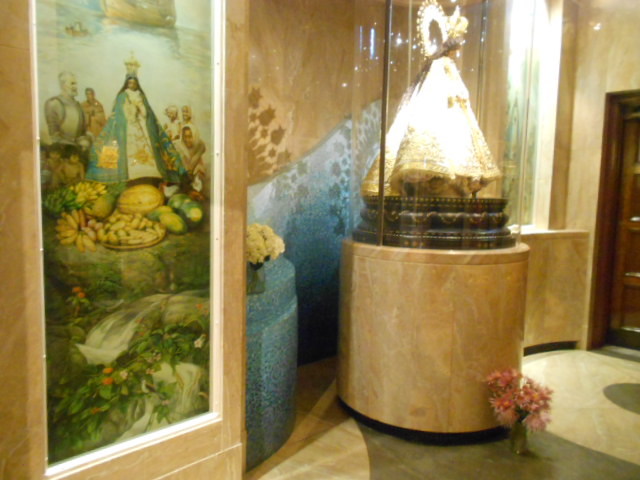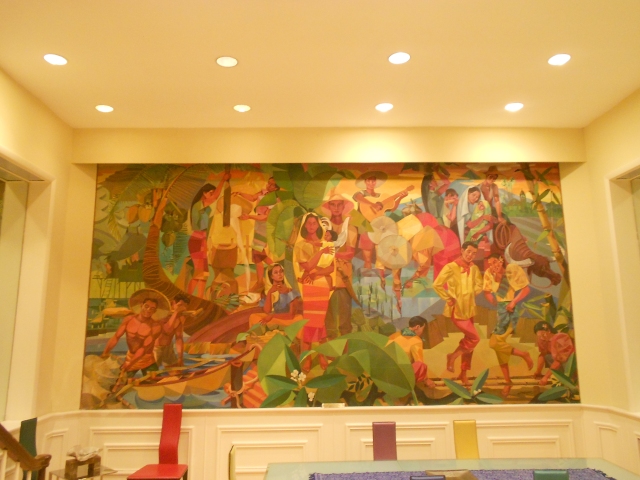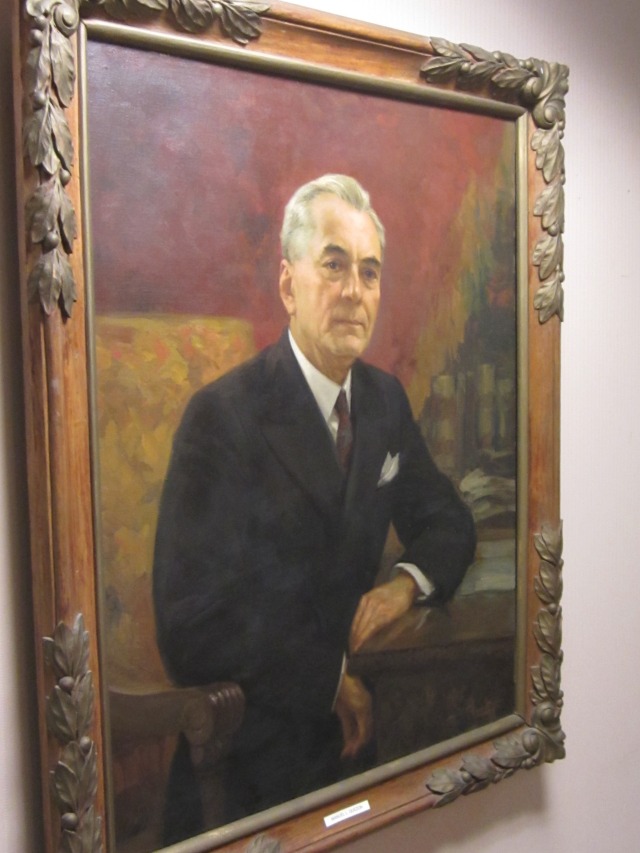A little over three years ago, we published an article in Asian Journal called “Finding Philippine Art in Washington, DC”. The article was about important Filipino artists who spent some time in the metro Washington, DC area and Philippine works of art that are among Washington’s collections or currently on display at an art gallery or museum.
Through personal visits or through digital archives, we have since collected images of several important works of art cited in that article. One of these artworks mentioned in the article is a painting in the JFK library by Philippine National Artist Fernando Amorsolo, “Philippine Village,” a gift from the Macapagal administration to US President John F. Kennedy, presented by President Diosdado Macapagal’s young daughter Gloria Macapagal, who later became a Philippine President herself. We also visited the National Shrine recently and took more photos of the Blanco paintings that frame the altar where an image of the Our Lady of Peace and Good Voyage (Our Lady of Antipolo) is enshrined.

Our Lady of Peace and Good Voyage at the National Shrine, Pedestal designed by Bobby Manosa and Chelo Hofilena, Photo from POPDC Collection

Blanco Mural, Photo from POPDC Collection

Our Lady of Peace and Good Voyage, Photo from POPDC Collection
We have a few new discoveries, too. The Philippine Ambassador’s official residence in Scott Circle features a large mural by Romeo Tabuena, a prominent painter and printmaker. Tabuena was commissioned by Gen. Carlos Romulo to paint this mural in the late 1950s—described in the The Washington Post as “bold in execution, strong in color, modern in technique” and had guests “gasping in admiration.” (Gen. Romulo’s former residence on Garfield Street, currently a privately owned building, supposedly has another Tabuena mural, but we have yet to confirm it.) We also visited the Philippine embassy a couple of years ago and saw a few Amorsolo portraits of Philippine Presidents on display. And here is Mr. Amorsolo painting those same portraits commissioned by the embassy.

Filipiniana by Romeo Tabuena, 1957, Ambassador’s Residence, Photo from POPDC Collection

Portrait of Manuel Quezon by Fernando Amorsolo at the Philippine Embassy, Washington, DC, Photo from POPDC Collection
Finally, not too long ago, we read about a second sculpture made by Philippine National Artist for Sculpture Guillermo Tolentino during his brief stay in Washington in 1919. (The first sculpture was of course the famous “Pax”, the small mother-and-daughter statue presented by Tolentino to US President Woodrow Wilson and still on display at the Woodrow Wilson House on 2340 S Street, NW. Many articles have been written about that fateful meeting—which, among other things, led to prominent business leader Bernard Baruch, Wilson’s friend, providing financial support to Tolentino’s art studies—including accounts in The Washington Post and the Evening Star in 1919, Tolentino’s own recollection published in the 1927, a chapter of a book written by Rod Paras Perez in 1976, and more recent articles by Ambeth Ocampo.)

Guillermo Tolentino in front of US Capitol, Reproduced from Paras Perez (1976), with permission from Dalisay Tolentino Mendez
A 1927 list of Tolentino’s artworks made while living overseas includes this second item, an 8-inch plaster sculpture called “Homesick.” Though we have been looking everywhere for a couple of years now, we have yet to find any trace or even a photograph of it. We like imagining what it must feel like to suddenly find it one day, while browsing at an antique shop in the suburbs, maybe in the middle of the Eastern Market, or at an antiquarian bookstore further away from the capital, in one dusty corner of the store propping up an ancient volume.
Not finding any trace of it anywhere in the city, however, also gives us a sense of what it must have been like for Tolentino—a young man, yet to fully discover his incredible artistic gifts, living overseas on his own for the first time. It must have been overwhelming at times as he wandered around a foreign city far from home, alone in the capital of the world’s newest empire, romance and remoteness at the heart of his overseas adventure—why else would he sculpt “Homesick”? Almost a hundred years later, we also wander around our adopted city, looking for traces of home and the remains of our cultural inheritance. And at every DC traffic roundabout—the vague, circling feeling that, despite all our finds, something precious may have been lost.
Bibliography
The 2014 Asian Journal article and this update drew from a growing wealth of references including the following: “Art World Plans Aided by Congress.” The Washington Post 26 Dec. 1926: F2; “Bal Boheme Plans Made as Mystery.” The Washington Post 9 Jan. 1927:F5; Baruch, Bernard Letter to Guillermo Tolentino cited in Ocampo, Ambeth. Aguinaldo’s Breakfast and More Looking Back Essays. Quezon City: Anvil Publishing, 1993; Crane, Jane Watson. “At Washington Galleries: Veteran and Tyro Show Skills.” The Washington Post 13 June 1948:B8; Delos Santos, Epifanio and AVH Hartendorp. “Guillermo E. Tolentino: Sculptor.” Philippine Education Magazine August 1927; “Detroit Unions Present Murphy Portrait to Court.” Cedar Rapids Tribune 21 May 1953:6; Duldulao, Manuel D. A Century of Realism in Philippine Art. Quezon City: Legacy Publishers. 1992; “Fahnsworth and his Wife have Exhibit.” The Washington Post 16 Jan. 1927: F5; Grefalda, Reme-Antonia. “Pacita Abad: D.C. Artist and World Gatherer.” www.oovrag.com. Our Own Voice Literary Journal. 17 Jan. 2005. Web. Accessed 17 Jan. 2014; “Keen Eye on Filipinos.” The Washington Post 1 Feb. 1899: 9; Kennicott, Philip. “‘Angels, Demons, and Savages: Pollock, Ossorio, Dubuffet’ Review.” www.washingtonpost.com. The Washington Post. 12 Feb. 2013. Web. Accessed 19 Jan. 2014; Magsaysay-Ho, Anita. An Artist’s Memoirs. Manila: Anita Magsaysay-Ho. 2000; McCardle, Dorothy. “Ambassador Pulls Off Artistic Coups.” The Washington Post 28 July 1957: F7; McNair, Marie. “Couldn’t Dine Like This Every Night.” The Washington Post 16 May 1953: 20; McNair, Marie. “Town Topics: Nona Quarles Airs Her Skill.” The Washington Post 20 Jul 1957: B3; McNair, Marie. “Town Topics: More PT Boats Launched by JFK.” The Washington Post 23 May 1963: D2; No Title. The Washington Post, 14 September 1985: B4; O’Sullivan, Michael. “Last chance for ‘Angels, Demons and Savages.’” The Washington Post 10 May 2013:T19; Ocampo, Ambeth “A stroll through Wilson House.” Philippine Daily Inquirer 28 August 2000; Ocampo, Galo Letters to Mac Perez cited in Ocampo, Ambeth. Aguinaldo’s Breakfast and More Looking Back Essays. Quezon City: Anvil Publishing, 1993; Ottoman, Klaus and Dorothy Kesinski. Angels, Demons, and Savages: Pollock, Ossorio, Dubuffet. New Haven and London: Yale University Press in cooperation with The Phillips Collection and Parrish Art Museum. 2013; “Pacita Abad: Woman of Color.” www.pacitaabad.com. Pacita Abad Art Estate. Web. Accessed 17 Jan. 2014; “Philippine Village.” www.jfklibrary.com. John F. Kennedy Presidential Library & Museum. Web. Accessed 19 Jan. 2014; Porter, Leslie Judd. “Gres Ending First Fine Season.” The Washington Post 8 June 1958: E7; “Obituary.” The New York Times 24 July 1949: E2; “The Prime of His Career.” www.fernandoamorsolo.com. Fernando C. Amorsolo Foundation. 2009. Web. Accessed 19 January 2014; “Quirino,” Portland Press Herald. 10 August 1949: 12; Tiongson, Ruel Hector R. “A Brush with Greatness.” positivelyfilipino.com. Positively Filipino LLC. 2 Oct. 2013. Web. Accessed 19 Jan. 2014; Wilson, Edith Letter to Guillermo Tolentino cited in Perez, Rodolfo Paras. Tolentino. Malolos: The National Art Foundation of Malolos. 1976.
We expect to update this bibliography again in due course.


You can also find paintings by Pacita Abad at the World Bank offices.
LikeLike
Thank you for reading our blog! Our 2014 article cited above mentions some of Pacita Abad’s works.
LikeLike
[…] and here: https://popdc.wordpress.com/…/finding-philippine-art-in-wa…/ […]
LikeLike